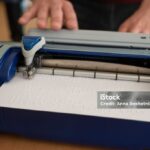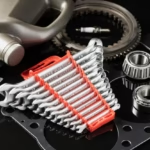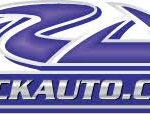Now Reading: Understanding Ink and Printer Compatibility in DTF Printing
-
01
Understanding Ink and Printer Compatibility in DTF Printing
Understanding Ink and Printer Compatibility in DTF Printing
DTF (Direct-to-Film) printing is gaining popularity in the custom apparel market. Designers first create unique and complicated design on a special film through a DTF printing machine and then apply it to any fabric. Because of the rising need for unique and top-notch apparel, more businesses or individuals are adopting DTF printing since it is quite flexible and has very appealing results.
However, in order to produce the maximum results, it is important to appreciate the role ink cartridges play in DTF toner printing. The type of ink has a direct influence on the color, longevity, and quality of your prints. Compatibility with your printer and ensuring that DTF printing is used accurately enhances performance. The quality of your ink cartridges improves the image quality of your custom apparel projects and allows for more unique design ideas.
Ink Cartridges for DTF Printing
To begin with, in the given scenario dealing with DTF cartridges, it is worth mentioning the different types of inks that can be used to enhance the overall output quality. High-quality inks found in specialized ink cartridges designed specifically for DTF printing are utilized in this method. Now it is time to consider the types of ink used in DTF printing and what differences do these ink possess as compared to the commonly used inks.
Types of Ink Cartridges Used in DTF Printing
- Pigment Ink Cartridges:
- Composition: Inks from pigments are those that contain particles in the form of solid colors floating in a carrier liquid. The color particles in these inks are durable and ensure good color saturation.
- Application: Both synthetic and natural materials can be used with this type of ink for DTF printing. This is because pigment inks have strong adhesion to many substrates like cotton, polyester as well as blends.
- Durability: These are resistant to fading and washing and thus the prints will sustain vibrancy over a long period of time. They are therefore well suited for use on clothes that require frequent washing.
- Dye Ink Cartridges:
- Composition: Dye inks are compositionally made of water soluble dyes which are able to dissolve in any liquid. They usually cover a wider color space and are used for print which needs very rich and vibrant colors.
- Application: Although it’s true that dyes can produce beautiful colors, they may not be able to coat all fabrics as well, therefore, these inks are not the best functional method for almost all areas related to DTF printing
- Durability: As compared with pigment inks, dye inks are prone to be less durable which tends to dry with time and cannot withstand frequent washing that well.
How DTF Inks Differ from Regular Inks
DTF inks are specifically formulated to meet the demands of the DTF printing process. Here’s how they differ from regular inks:
- Composition: The DTF inks were specially developed to withstand heat and properly bond with the transfer film allowing the application of the designs on the cloth. Normal inks, such as those contained in the ordinary ink jet printers, do not possess the necessary qualities for the DTF application; therefore, when embedded in these conditions, resl umaa yield poor results.
- Application: To apply the DTF inks, printing is done on a specialised film that will be heat pressed onto the fabric later. Common inks are only meant for direct printing on the substrates which may not be viable for transfer as their quality and reliability are likely to be compromised.
- Durability:The DTF ink formulations are made to endure all washes and the fading of odor which will be an added advantage to the life of the prints. Inks meant for wearables such as clothes, regular inks, may not have enough durability that gives the required lifespan of the clothes.
Using the proper cartridges for DTF designs will also give you bright prints that last. Composition, application techniques, and durability attributes of the inks vary; it is important to know them while deciding for any particular printing task.
Choosing the Right Printers for DTF Printing
When it comes to DTF printing, the printer that you choose is very important as it determines the quality that you will achieve. Such printers, which are specifically designed for DTF printing, are able to meet the specific requirements of that process so that your designs are successfully transferred onto the fabrics. Let’s find out what these printers are all about and mention some popular ones that work with DTF ink.
Explanation of Printers Specifically Designed for DTF Printing
DTF printers are built for the DTF printing process which entails transferring designs printed on a special transfer film onto the fabric being printed. These printers have the following characteristics in common:
- Direct Ink Delivery System: DTF printing process which entails transferring designs printed on a special transfer film onto the fabric being printed. These printers have the following characteristics in common.
- High Print Resolution:One of the advantages of DTF print devices is that they provide high print resolutions owing to their detail-oriented design. This is necessary for proper hexachrome colors, precision lines on customized apparel along with other elements of different designs.
- Compatibility with DTF Inks: These printers are in most cases compatible with DTF inks designed products in order to ensure proper performance.
- Built-in Curing or Drying Features: There is also a drying unit built into most DTF printers to instantly dry the ink on the transfer film which makes the printing procedure more productive.
Popular Printer Models Compatible with DTF Ink
Here are some popular printer models that are compatible with DTF ink and are widely used in the industry:
- Epson SureColor F-Series:
- Features: The Epson SureColor F-Series printers are popular for their excellent color reproduction, advanced print head technology and outstanding output quality. They are versatile and can handle a variety of substrates, making them a popular choice for DTF printing.
- Epson EcoTank ET-2720:
- Features:This highly modified printer is affordable as well as compatible with DTF Printing. Small businesses as well as hobbyists can benefit from its refillable ink tanks which help lower the printing costs as well as deliver printing without interruptions.
- Mimaki JV Series:
- Features: The Mimaki JV series printers are well known for their incredible color quality and printing speed, which makes them very effective for DTF applications. They have advanced features such as printing in white ink that allow them printing on black fabric, which is a big plus when printing custom clothes.
- Roland VersaUV LEF Series:
- Features:These printers are particularly noted for their ability to print in flexible fabrics among a variety of materials. The LEF series comes with UV printing capabilities which allow them printing through DTF method with high standards of quality.
- Brother GTX Series:
- Features:.True to their name, the Brother GTX printers are employed for direct to garment printing, however this method can be modified for DTF printing. They have a reasonably user friendly interface and high resolution printing facilities, which would suit someone aiming for DTF applications perfectly.
In your DTF printing processes, the selection of a printer is an important step. When you use a printer like that which is made for DTF printing and is compatible with DTF inks, you will have your designs printed and looking good. There is a clear wp or hwp reference, whether you go for a more expensive machine or a less expensive machine, that machine is worth investing in if you want to succeed in the market for custom apparel.
Using DTF Ink in Regular Printers
One of the questions those getting started in DTF printing has is, “Can I use DTF ink in any printer?” However, for those who have a regular printer and are considering using DTF ink for it, you must first comprehend the things that can be done and the things that cannot be done with this method.
Can a Regular Printer Be Used for DTF Printing?
Theoretically, DTF inks can also be printed by using regular inkjet printers, however there are a few conditions that need to be understood:
- Printer Compatibility:It is a given that all printers cannot be used all over and that specific printers are able to do specific jobs. In any DTF process, use of DTF inks is a must, therefore a printer is required that possesses the appropriate ink delivery systems, capability and features. Standard printers may not have the adequate capabilities to enable the delivery of the ink at satisfactory pressure which enables the DTF processes.
- Modifications Required: There are some standard printers that will require certain changes before use for DTF printing processes. Such changes may include and are not limited to – changing the printer ink delivery systems which can be tricky and break warranties of manufacturers. Also changes may not always assure correct pathways to succeed and may even result in poor quality of printed media ultra-fast.
- Print Quality: DTF printing was not in mind when making regular printers so they are bound to fail to achieve optimal results for DTF application. The transfer film will be poorly designed simply because the inks have poor bonding with the film. Therefore any graphics printed on such poor bonds will appear faded and blurry when drawn onto fabrics.
Risks and Issues When Using DTF Ink in Non-DTF Printers
Using DTF ink in a regular printer poses several risks and issues:
- Clogging and Maintenance Problems: DTF inks are known to cause clogging in non DTF designed printers evoking regular printer maintenance problems. Normal printers designed in this manner may not be able to handle the thick viscosity of DTF inks leading to the wiper blades turning in vain and printing heads getting blocked.
- Inconsistent Results:There are printers which are not compatible with other materials and that results in a lot of problems like some areas being too dark and other too light when transferred onto film or poor compliance with the adhesive film. This in particular leads to messing with the expectations of the end users who are focused on ensuring that their prints look perfect and of professional quality.
- Durability Concerns: There is a concern that prints created with DTF inks in penetrated zone non penetrated DTF printers will not have the same durability, and washing grade as prints created with pensitrated zone properly configured DTF printers. As a result, this will limit the potential use of the final product for long periods, especially in clothing items which will be washed many times.
- Voided Warranties: Modifying the regular printers for DTF printing will mean that the original warranty of the regular printers will be breached and this means that you will not get any assistance when things go wrong. This is largely due to the possibility of obtaining monetary value through order potential if they are delivered and also recuperating costs of altering the gear.
As a rule of thumb, Although the prospect of employing DTF ink in standard printers holds some promise, its limitations and hazards typically outweigh the advantages. Failure to invest in a printer that is ideally suited for DTF will not yield favorable outcomes. In this way, compatibility is not an issue; maintenance requirements are reduced, and final prints will be of acceptable quality for custom-made fabrics.
Modifying Regular Printers for DTF Printing
The question “Is it possible to do DTF printing with regular printers?” comes up for some users as the market for DTF printing expands. The short answer is yes, but it will require some work. It is indeed possible to use a regular inkjet printer for DTF applications, but there are many requirements for modifications to make it possible. In this article, we describe how to convert an ordinary printer for DTF and the difficulties you will encounter while doing so.
How to Adapt a Regular Printer for DTF Use
- Ink System Modification:
- Install a Continuous Ink Supply System (CISS): DTF inks are considerably more viscous than standard inks, as they require their own distinct ink delivery system. CISS inks come in numerous varieties – DTF inks can be supplied in waste ink tanks, preventing print head’s from becoming clogged.
- Replace Existing Ink Cartridges: Standard ink cartridges should be replaced with DTF ink cartridges that are compatible with the printer. It is important to use cartridges that are made specifically for DTF printing so as to not damage the quality.
- Printer Head Adjustment:
- Modify the Print Head: Depending on the printer model, the head might need to be adjusted – either the height of the print head or the temperature settings to allow for the thicker DTF ink to apply more easily.
- Software Configuration:
- Use Compatible Software: Download programs that are intended for DTF printing such as those with DTF ink with paper transfer profiles; DTF inks come transfer profiles. This is due to the fact that the software allows for proper color and print settings.
- Heat Press Setup:
- Purchase a Heat Press: Since a heat transfer machine is required in order to transfer the designs on to the garment through DTF printing, it is necessary to have at least one. When doing this, be certain that it is correctly calibrated.
Challenges of Converting a Standard Printer to Handle DTF Printing Effectively
While it is possible to use any regular printer for DTF printing, there are many complications that can be caused by this approach:
- Print Quality Issues:
- The effort put in printing using DTF printers yields great results, unlike the DTF printers. Thus dedicated printers for this purpose will always produce better quality images.
- Clogging and Maintenance Problems:
- DTF inks have greater viscosity than most other inks in the market. It is because of this that the heads on the printers become clogged frequently; especially those which have not been developed specifically to handle DTF inks.
- Compatibility Concerns:
- There is a degree of difficulty associated with retrofitting a standard printer to DTF printing. Different models have different compatibility for DTF inks, thus some printers simply would be ineffective for this application.
- Voided Warranties:
- If you choose to retrofit your printer, the standard warranty which applies to printers of this type will become void. Problems would arise in the future without ever having a solution.
- Learning Curve:
- One of the key transitions to DTF mk printing is the requirement to learn new processes. These processes include various print settings, heat transfers along with the upkeep and care of the inks.
Conclusion
In summarizing, DTF printing’s success level depends on the knowledge on what should be considered when selecting the ink cartridges for DTF printing, what ink is to be used in DTF printing, and what printers are capable of DTF printing.
To obtain vivid long lasting prints, only specialized DTF inks and printers should be used. Regular tests among other maintenance activities should be carried out to ascertain print efficiency.
By adhering to the above guidelines as well as being up to date on developments in DTF technology, amazing custom promotional garments designed to fit the niche will be made. The Cardinal Principle of DTF printing is creativity; do not be afraid to unleash it.

































